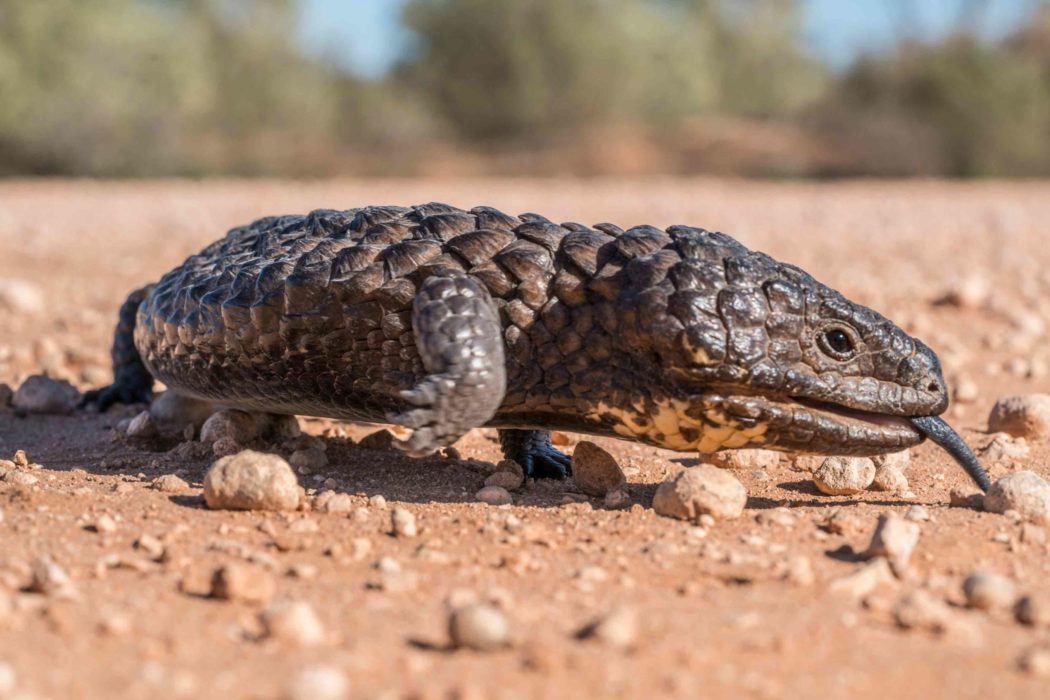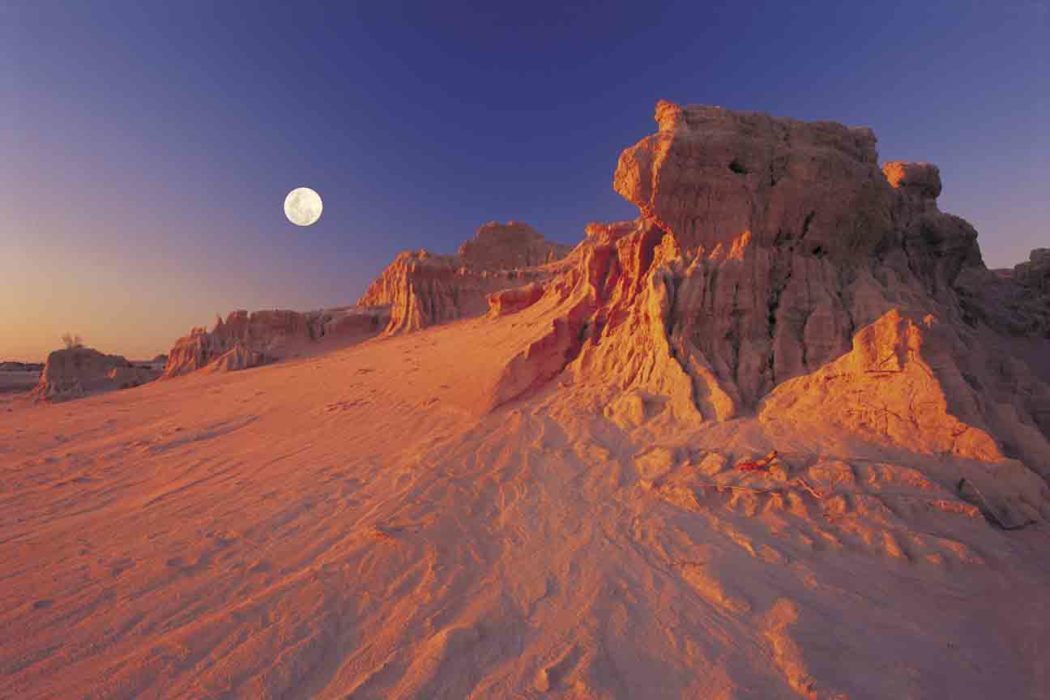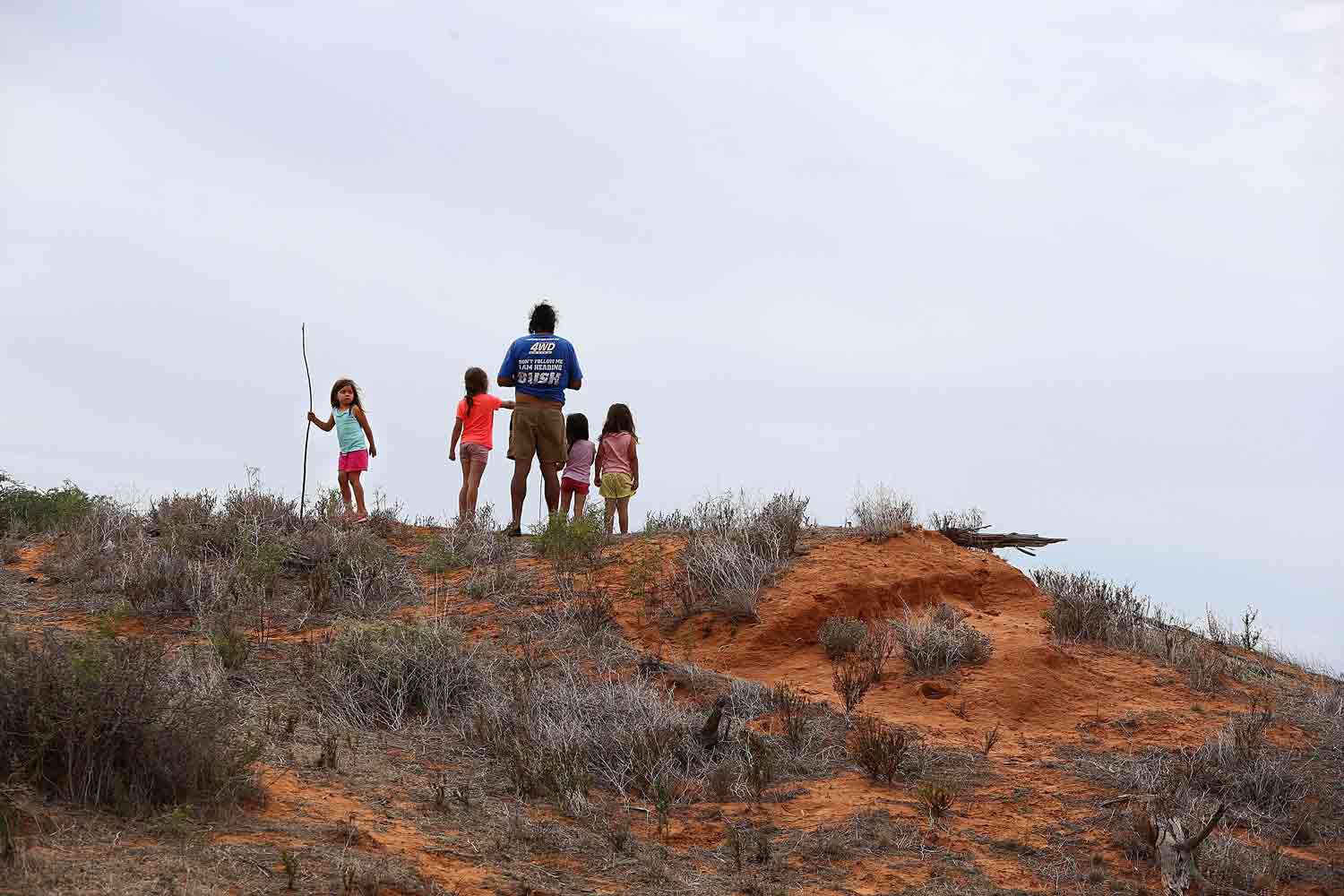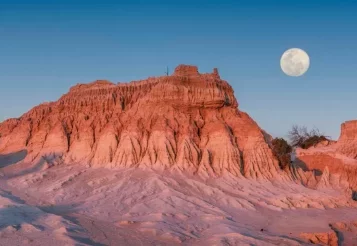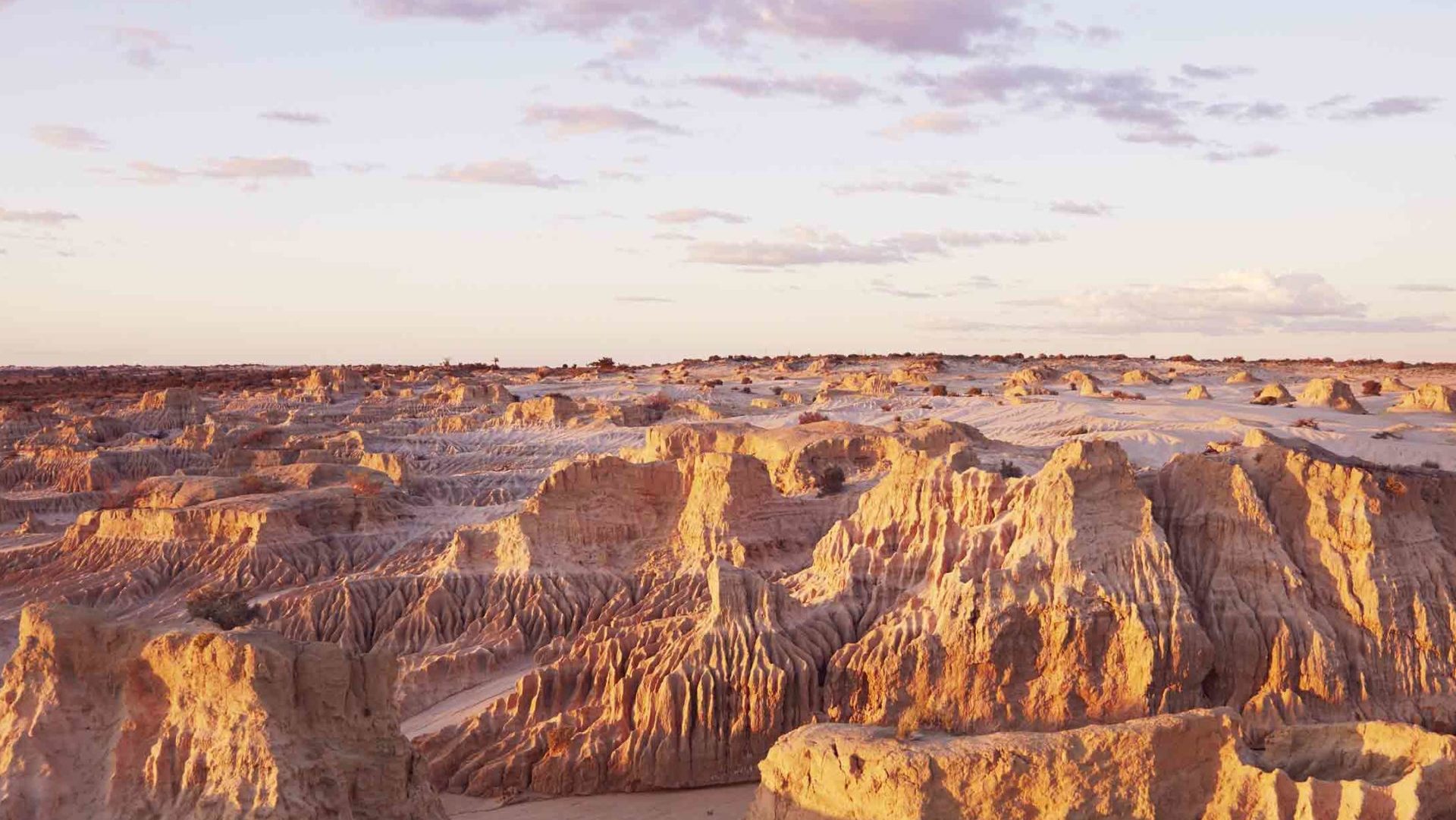
Travel Mungo National Park – In Mungo’s Footsteps
Words: John Pickrell | Images: Michael Amendolia
I am sitting on a dune 50m above the saltbush plains at Mungo National Park in south-western New South Wales. A cool breeze carries with it fine grains of silica, and the soft glow of first light is beginning to illuminate a series of emu tracks that trail past me and disappear over the crest of the dune. Just a little while earlier, the Milky Way had been a clear streak across the sky, and Venus, Mars and Saturn were all bright points of light. There was even the brief and exciting flare of a shooting star – a distant traveller met with a fiery demise.
First Nations people have camped here on this very dune and others like it in the Willandra Lakes Region World Heritage Area (WHA) for more than 50 millennia, beginning long before modern humans had even arrived in Western Europe. On countless occasions, they have looked out at the rising sun and seen the same night sky awash with twink-ling stars. Beneath me in the dune are their stone tools, the baked hearths of their cooking fires, and their carefully buried or cremated human remains.
Here, perhaps more than anywhere else in Australia, you can feel a connection to the First Peoples. They were at the front of a wave of migration that carried small bands of travellers on an almost implausible journey from Africa. The first occupation sites in Australia are below today’s sea level, so we’re unlikely to find traces of them. Perhaps the earliest evidence of these migrants is a rock shelter, Madjedbebe (formerly known as Malakunanja II), located about 50km inland from the Arnhem Land coast.
Here, alongside rock art, the remains of stone tools, grinding stones, ochre and charcoal have been found, the oldest of which are about 55,000 years old. The next evidence we have of people living in Australia comes from Mungo NP and the wider Willandra Lakes area. In geological layers dated as far back as 50,000 years, there are stone tools and hearths, shellfish middens and the bones of butchered animals.
When, in 1969, Professor Jim Bowler stumbled upon the cremated remains that came to be known as Mungo Lady, it suggested Aboriginal people had been here far longer than scientists suspected. But it was his 1974 discovery of Mungo Man that really startled the world.

The collapse of the ‘lunettes’, or dunes, at Willandra – caused by grazing from rabbits and sheep – has created structures such as the Walls of China.
In 1974, then aged 44, Jim was working as a geologist with the Australian National University (ANU), in Canberra, looking at rocks in the south-western corner of NSW to find clues about ancient climate change; he wasn’t an archaeologist and he hadn’t set out to find human remains. “I wanted to unwrap the story of the climatic legacy written in the Australian landscape,” Jim tells me when I meet him years later at Mungo on a warm autumn day, the air thick with flies. “My agenda was to explore the dry inland, the dunes and salt lakes. I was reconstructing the impact of Ice Age climatic change.”
Few Europeans had explored the now-dry ancient lakebeds that spanned the sheep stations in this remote spot. Jim was the first European to map them. “I was able to identify the shorelines, and in them find stone tools and shells and evidence of human remains. That completely changed the importance of the system,” he says.
Here, in 1968, he had found Mungo Lady – hundreds of fragments of bone, now known to be the world’s earliest recorded cremation. Although the true age of this find was not realised until later, it was clear it was a globally significant discovery. At this time, scientists believed Aboriginal people had arrived in Australia some 15–20,000 years ago, but this figure was about to be corrected dramatically.
In 1974 prolonged rain confined Jim to the shearers’ quarters at Mungo station. On 26 February the conditions improved and he was excited; heavy rains expose new artefacts. Little did Jim realise that this would be a historic day. “I hunted along in the same area as Mungo Lady. In that part of the landscape, when you get your eye in, you can follow a particular geological horizon – it’s like a geological map, with layers that are 20, 30, 40,000 years old,” he recalls.
Less than half a kilometre from where Mungo Lady was found, he stopped dead in his tracks. “I spotted the tip of a white bone. I brushed away and it was clearly a skull…and I brushed away a bit further and the mandible [jaw] was attached. And I thought, Holy shit! This is the companion to Mungo Lady. I raced to the nearest shearing station and got on the telephone to Canberra… I thought, I’m not going to touch this; this is a specialist job.”
It was another day before archaeological heavyweight Professor Alan Thorne arrived from ANU with a truckload of assistants and the excavation began. They had only to strip off 10–15cm of topsoil. Rarely are excavations this simple. A deeper trench was dug to reveal sediments above and below the skeleton, which could later be used to help date it. It wasn’t until much later (and after significant scientific debate) that a series of studies confirmed that both Mungo Man and Mungo Lady were about 40–42,000 years old. Jim’s knowledge of geological layers meant he already knew that these remains were older than any thus far uncovered in Australia.
As the excavations proceeded, the researchers found red pellets and staining in the grave. It began to dawn on Jim that this was a kind of ochre used as body paint by First Nations people today. “There’s no ochre for miles around here – you have to transport it. Then you have the ritual of grinding the ochre. There was a fire alongside the burial…so perhaps a smoking ceremony. The ochre was ground up and painted or sprinkled on.”
Either way, it demonstrates this community around him was in mourning. It’s the sort of ceremony and ritual that does justice to any church service today. These were among the world’s earliest recorded funerary rites.
The bones of Mungo Lady and Mungo Man, as well as the fragmentary remains of as many as 100 other people found at Willandra, made their way into ANU collections in Canberra during the 1970s and ’80s. The NSW state government purchased Mungo station and turned it into a national park in 1979 (funds from Australian Geographic’s founder, Dick Smith, helped establish the visitors centre, which includes a small museum). Gazetting of the larger WHA followed in 1981. However, unease and resentment would grow in the following years, because the remains were removed from Willandra without consultation with people from the area’s three Aboriginal language groups, the Paakantyi (also spelled Barkandji), Ngiyampaa and Mutthi Mutthi peoples.
The Willandra Lakes Region WHA consists of 19 dry relict lakes that were once filled with glacial meltwater flowing east along the Willandra Creek from the Great Dividing Range.
As the last ice age waned 12,000 years ago, water no longer flowed from the highlands to replenish the lakes, the last of which dried up 17,500 years ago. The fossils of more than 55 animals have been found in the lunettes – snakes and wombats, but also extinct species such as Procoptodon and Genyornis newtoni. Alongside the animal fossils are stone tools and ancient fireplaces that reveal extensive human occupation. Most significant, though, are the human remains scattered throughout the eroding dunes.
“Some of the very earliest modern human remains in the world are here at Mungo,” says Harvey Johnston, an archaeologist with Heritage NSW, who’s been involved with Willandra since the late 1980s. “You have this record of human occupation going back 40,000 years and burials and ceremonies associated with that: cremations, burials with ochre, multiple individuals and burials with unusual features.” A number of other scientifically significant remains have been discovered at Willandra, but none have been disturbed or studied, in line with the wishes of the area’s Traditional Custodians. Mungo Child, as it has become known to scientists, was discovered in 1987, and may be of similar antiquity to Mungo Man. When the top of the juvenile skull was discovered, just a few centimetres of sand were brushed off it before it was reburied. “It was never fully excavated,” Harvey says. “Some years later, part of the mandible became exposed through natural erosion, and confirmed it was clearly an adolescent or child.”
Together with the Paakantyi and the Ngiyampaa peoples, the Mutthi Mutthi are the Traditional Custodians of Willandra today. Mutthi Mutthi Country lies east and south of Willandra, encompassing sections of the Murray, Murrumbidgee and Lachlan rivers. Paakantyi land stretches north from the Victorian border to Broken Hill and Wilcannia, and includes sections of the Darling River and its tributaries.
The issues surrounding the unearthing and scientific study of human remains at Willandra are complex and sensitive. The Indigenous community feels it has an unbroken connection with the people buried here, a responsibility to see their spirits left in peace.
Ngiyampaa Elder Roy Kennedy says his people are unhappy about what happened here in the 1970s and ’80s. “They just come in and dug them out of the ground, took them to Canberra without any consultation. That, in my book, is wrong,” he says. “It’s alright for white blokes to come out here and dig up Aboriginal people, throw them in a box, take them down to Canberra and scan them, turn them over and put them back in their box. But if we’d tried that – went into a white fella cemetery and done that – we’d have been shot.”
Paakantyi man Ricky Mitchell is a community project coordinator with the Willandra Lakes Region WHA. He campaigned for the remains to be returned to the Traditional Owners, arguing that they were “crying to come home to Country. The Country where they’re held, it’s not their Country. They want to come back out here and then they’ll rest.”
In the 1970s, when Mungo Man’s remains were estimated at 40,000 years old, this was startling for many, though perhaps not for First Nations Australians, who’d always known from their Dreaming narratives that their ancestors had been here a long time. It was modern science confirming what Aboriginal people knew all along, says Harvey.
Nevertheless, the discovery was profoundly significant and its implications still reverberate today. The phrase “40,000 years” was quickly adopted by land rights campaigners and became a tremendously powerful political statement used to reinforce messages of Indigenous heritage, history and ownership.
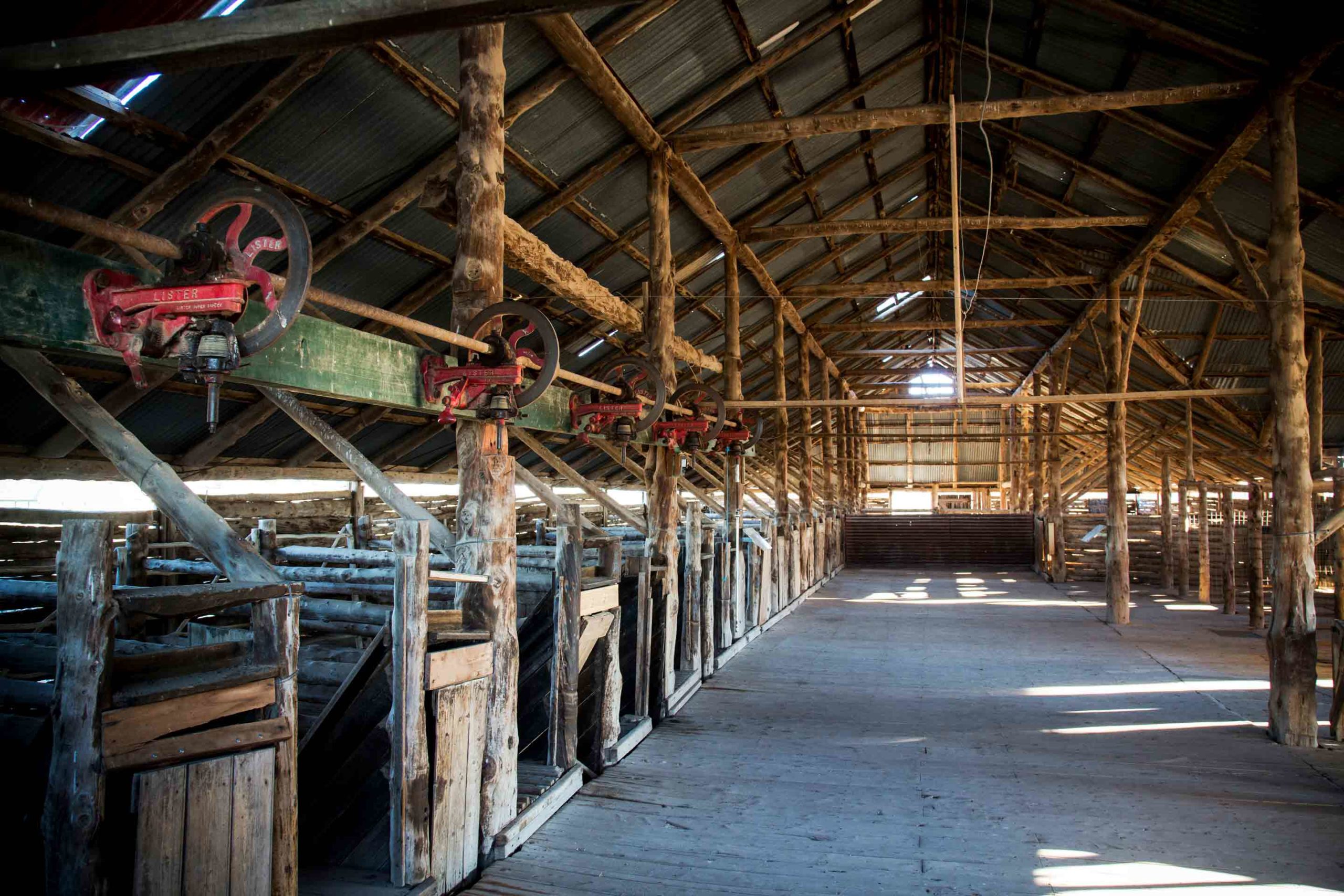
The national park still has historic building such as the woolshed, where up to 18 shearers at a time once toiled in to shear 50,000 sheep in a year.
On 25 February 2014 almost 40 years to the day since his extraordinary find, Jim made an impassioned plea in a number of newspapers for Mungo Man to finally be returned to Willandra. He argued that the bones had yielded all they could to research and that ANU should fast-track their return. “Keeping him in a cardboard box for 40 years is long enough,” he said. “It’s time for him to come home to his country. I won’t be here in another 10 years, and I feel a sense of responsibility.” Three years later, Mungo Man, together with the remains of 104 others, were finally released by ANU and went on their last journey to be returned to Country.
Forty-two thousand years ago, people at Willandra lived a relatively easy life. Game was abundant and fish were easy to catch. Aged about 50, the man whose remains came to be buried in the Mungo lunette was coming to the end of his life. He had watched his final sunrise and sunset over the top of the dune.
Four decades of throwing spears had given him an arthritic elbow, and on his last night, he sat by the fire rubbing it for the last time. His teeth were similarly worn from a lifetime of stripping water reeds to make twine. He would have known that his time had come.
After he had breathed his last, his body was treated with respect and dignity, and, after a ceremony to mark his passing, it lay undisturbed in its grave for an unimaginably long period of time.
Now, finally, Mungo Man and the remains of the other inhabitants of the area lie in peace once more in a beautiful, ancient land that has remained remarkably untouched over an eternity of human existence.



